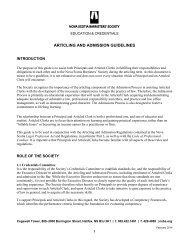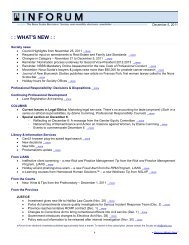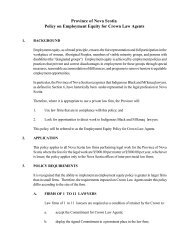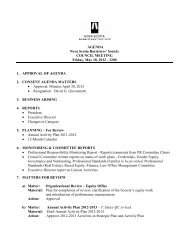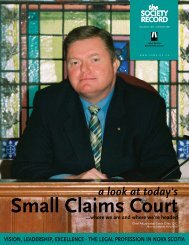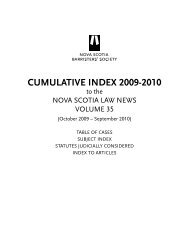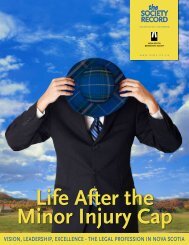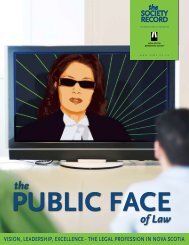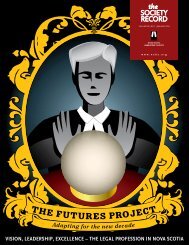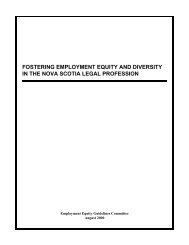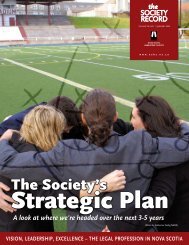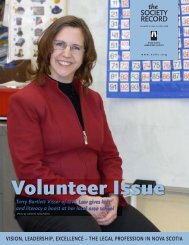SR Vol 27 No 4, October 2009 - Nova Scotia Barristers' Society
SR Vol 27 No 4, October 2009 - Nova Scotia Barristers' Society
SR Vol 27 No 4, October 2009 - Nova Scotia Barristers' Society
- No tags were found...
You also want an ePaper? Increase the reach of your titles
YUMPU automatically turns print PDFs into web optimized ePapers that Google loves.
ole as an icon in the struggle for Aboriginal justice and treaty rights.It did bring him a measure of peace that had eluded him previously.For Junior, his public existence was not a location where he found anypeace. Always reticent and reserved about his public profile, Juniorwas happiest in private pursuits and dimensions. Yet he was forced tolive most of the <strong>27</strong> years following his release from prison as a publicfigure. His life became a narrative constructed around his wrongfulconviction. He was a man almost continually engaged in struggle:from his long fight for justice to the treaty rights case. And thenthere was his battle to survive the lethal deterioration of his lungs andthe treatment that saved his life. It was all played out in the publicdomain, the occasions of his triumphs and when he stumbled.Junior did, however, take pride in his legacy and recognized thesignificance of what his sacrifices had achieved. He understoodthat while the Commission’s finding on racism—that he had beenconvicted and sent to prison, “in part, at least, because he was aNative person”—had not drilled down deeply into the bedrock ofthat racism to look at “colonialism, ... wrongful dispossession ofAboriginal lands, ... cultural hegemony, and ... state-sanctionedreligious proselytization, as the basis for systemic racial discriminationin the criminal justice system” (Mary Ellen Turpel/Aki-Kwe, “FurtherTravails of Canada’s Human Rights Record: The Marshall Case,” inElusive Justice—Beyond the Marshall Inquiry, Fernwood Publishing,1992), it opened a pathway for dialogue between the Mi’kmawpeople and government that remained of vital concern to Junior forthe remainder of his life.Immediately after the Marshall Commission’s Report was madepublic, the process for re-evaluating Junior’s compensation, animatedby Recommendation 8 of the Commission’s Report, began withthe establishment of a Royal Commission of Inquiry headed byJustice Gregory Evans. It concluded in July 1990, by which timethe Canadian Judicial Council’s inquiry into the conduct of theCourt of Appeal judges was underway. For Junior, it all required thesummoning of additional energy and reserves. It was now eight yearssince his release from prison and his life continued to be defined byhis wrongful conviction. That he was in time able to assume a freshidentity defending Mi’kmaw treaty rights was a testament to hisresilience and the durability of his cultural connections.Junior’s resilience was tested, at times to its limits, during his longstruggles for justice. Often he felt as though his life was one long,unremitting fight of one kind or another. I wish somehow it couldhave been possible for him to put it all to rest but there alwaysseemed to be another challenge to face. Despite these challenges, itwas Junior’s body, not his spirit, that gave out in the end. Junior hadslipped close to the edge in the past but I, like many others, had notanticipated the end when it finally came.Junior did not dwell in the past but the burden of it remained withhim, even though he was ostensibly a free man. It is a burden wemust now carry in honour of his memory to ensure that the lessonsimparted by his life are not lost or forgotten. And so, when I think ofJunior, as I often do, I remember a complicated and compelling man;a man who could have been filled with bitterness and hatred butwas not. A man who had much taken away from him and left muchbehind, who changed those of us who knew him—and our system ofjustice—for the better.presented by the Risk and Practice Management ProgramSolo and Small firm conference<strong>No</strong>vember 30th | Best Western Chocolate Lake Hotel, 20 St. Margaret’s Bay Road, HalifaxSessions will appeal to lawyers, office managers, paralegals, and legal assistants.Lawyers and staff from all sized firms are welcome.Session Highlights:• 60 Tips in 60 Minutes - Practical tips and ideas for improvedclient service, billing and finances, marketing, technology/practice management, and claims prevention• Legal Technologies for Solo and Small Firms• Business of Law: Improving Your Bottom Line -Understanding Finances, Billing and Profitability• Managing Human Resources - Tips on Hiring, Training andRetaining Staff in Your Law Firm• Organizing Your Electronic Data in a Paperless and E-DiscoveryWorld - Advising Your Clients and Being Prepared Yourself• Role of Risk Management - How it Affects Your Firm’sWell-Being• Vendor ExpoRegister now!For more conference details and to register, visit lians.caRegister before Oct. 30th and save on conference registration and hotel fees!Price: Early Bird Rate: $200 plus HSTAfter Oct. 30th: $250 plus HSTDiscounts for two or more registrants from the same firm!Key speakers include Dan Pinnington, David J. Bilinsky and Deborah E. Gillis QCDan Pinnington LLB/JDDirector of practicePROLawyers’ Professional IndemnityCompany (LAWPRO), TorontoDavid J. Bilinsky LLBPractice Management AdvisorLaw <strong>Society</strong> of British ColumbiaDeborah E. Gillis QCRisk and Practice Management AdvisorLawyers’ Insurance Association of<strong>No</strong>va <strong>Scotia</strong>See LIANS.ca for other notable speakers and bios.<strong>October</strong> <strong>2009</strong> 19



